“Battlefleet Gothic: Armada” Review
A magnificent ship, no doubt, but is it all show?
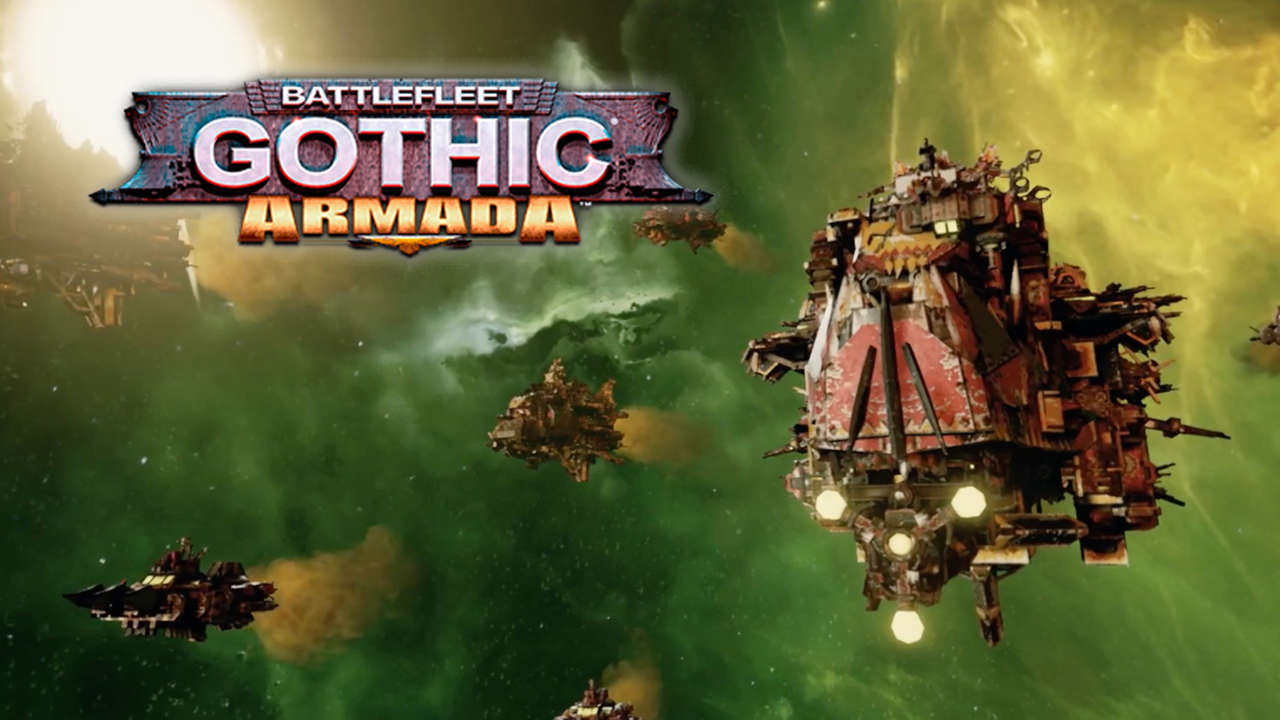
In the far flung and distant future, there is only war! Having already explored the wars raged on planets, it’s now into the deep reaches of space that we travel. Titanic ships clashing through the Gothic sector for superiority, with a healthy dose of explosions.
Adapted from Games Workshops now-unsupported table top game, “Battlefleet Gothic: Armada” brings to life the violent and immense world of naval battles in the 40k universe and does it with an impressively destructive sense of detail. Four factions, The Imperium, Chaos, Orks and Eldar have been painstakingly recreated in wonderful detail for the game. We have been given a near perfect visualization of what countless gamers and hobbyist from years past strived to recreate with paint and brush. The Imperium with vast ships covered in gothic imagery - almost flying cathedrals to the Emperor and decorated as befits the chosen of their god. Chaos, with its ancient battleships long twisted by the forces of chaos, hulking behemoths of metal decked in skulls and spewing gunfire from demonic visages. The Orks are perhaps the most interesting to see on the battlefield with huge ships that appear little more than floating wreckage, ragtag parts and weapons hammered in place and covered in thick armour. The Eldar, the most elegant of all races with their sleek designs and solar sails designed for speed and maneuverability rather than protracted broadsides of the Imperium, the strength of Chaos, or the brutality of the Orks. There is a 5th faction, the iconic Space Marines however these are a DLC only faction that comes with both pre-ordered and enhanced editions of the game.
There is a 5th faction, the iconic Space Marines however these are a DLC only faction that comes with both pre-ordered and enhanced editions of the game.
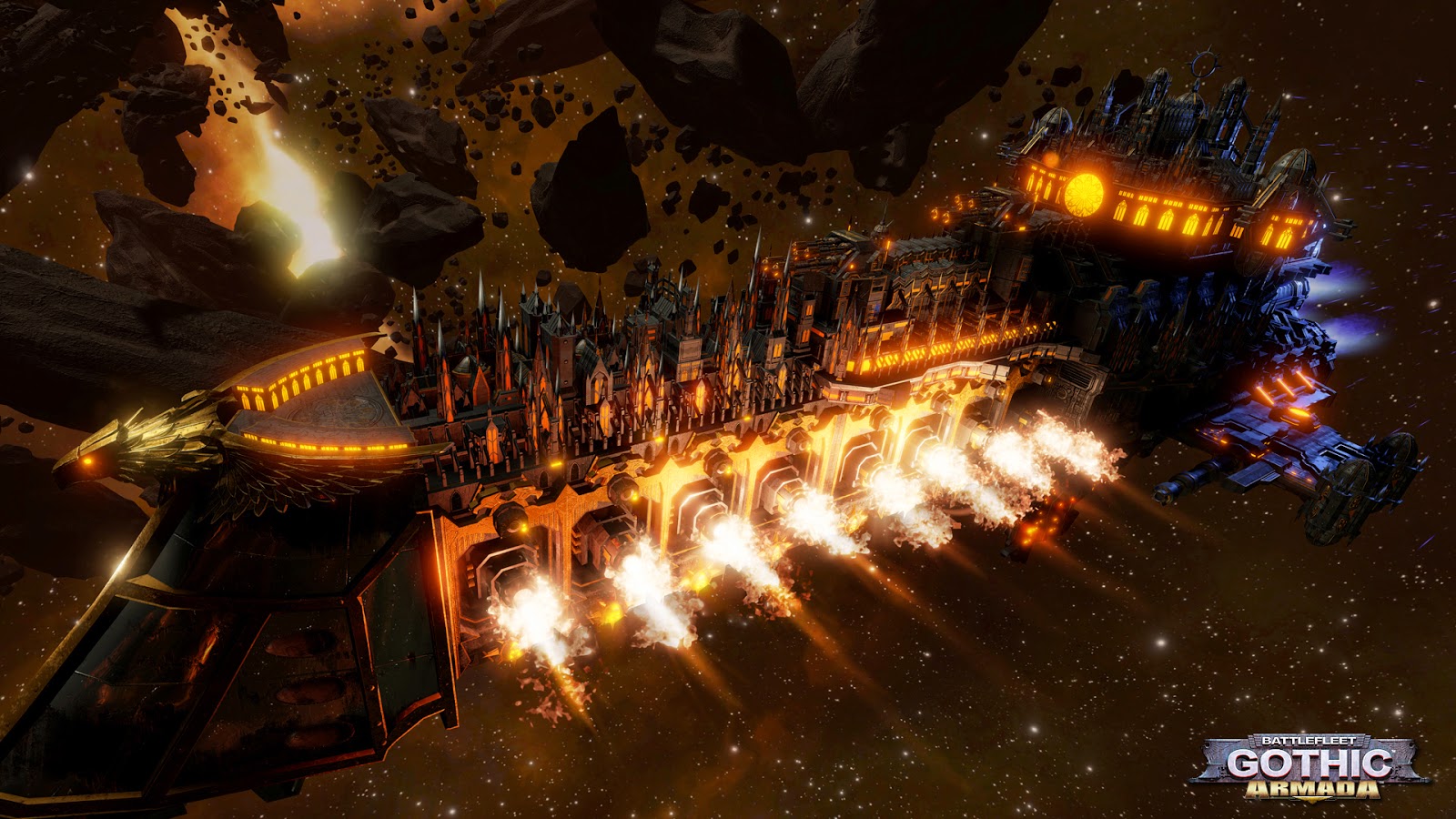
The fleets from the table top game each had their own unique qualities, and this has been translated well into their capabilities and options in game, providing each faction with their own interesting strengths and weaknesses. An area they can excel at on the battlefield, though it comes at the expense of a particular style of play. As the Admiral, it is up to you to utilize and counter all styles of play throughout the game. It’s here where the strategy of “Battlefleet Gothic: Armada” comes into its own, admirals vying for superiority throughout battle and jockeying for position and utilizing their ships to the fullest.
There are three options for play in the game, the Campaign, Skirmish and Multiplayer with the latter two being slight variations on one another. The campaign explores the Gothic sector of space and has players follow a newly-risen admiral and his fight against the Emperor’s enemies. The Skirmish and Multiplayer modes allow players to start a new fleet and admiral from their choice of faction and level up either against the AI or other players. As your ship[s gain experience and your fleet gains renown (the in-game currency), you are able to purchase varying equipment for the ship and pay for upgrade crews. These will either provide you with a usable ability during the course of the battle such as stasis bombs, increased shields or increased firepower or in the case of crew upgrades a permanent boost to accuracy, critical chance or morale..
Everything is persistent, lose a ship or lose a battle and there is no rewinding time to correct your mistakes. Fans of "Mordheim" will be familiar with the system. In truth this game draws many similarities with "Mordheim", replacing warbands with fleets and stats with crew-members.
Campaign
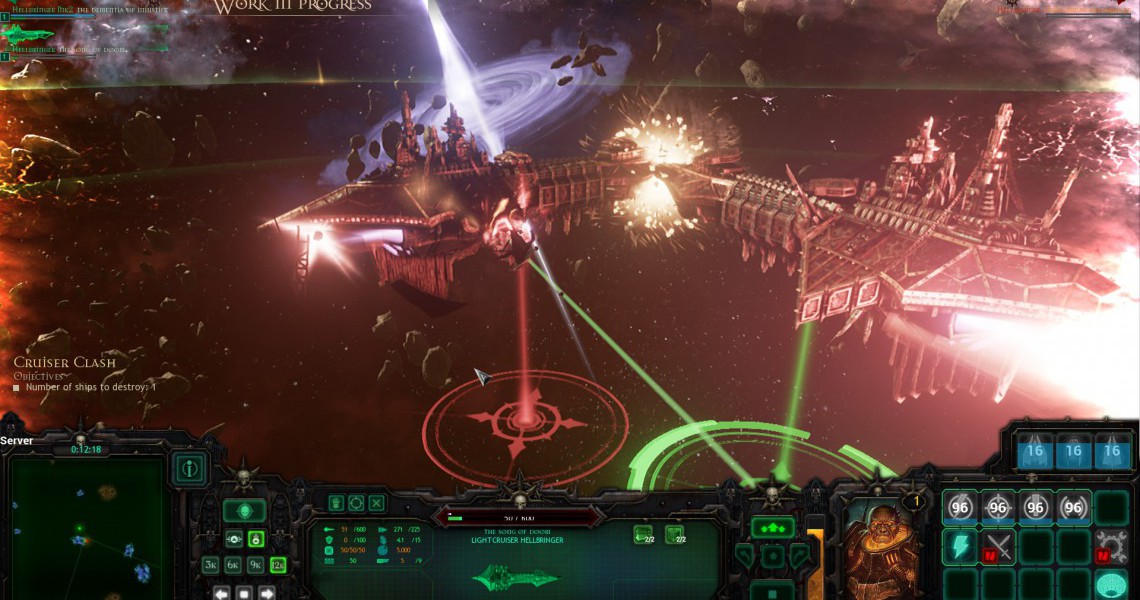
The story of “Battlefleet Gothic: Armada” finds new Admirals thrust into the burgeoning war for the Gothic sector. Cut off on patrol by a small fleet of Chaos ships, the players get to experience the horror and glory of battling with city-sized ships and sending the Emperors foes back to the abyss. The campaign is perhaps the most detailed and in-depth portion of the game. Where multiplayer and skirmish modes allow the player to fight battles using their customized ships, the campaign requires the management and protection of a whole star system. Worlds provide resources and bonuses in and out of combat and must be defended from the encroaching enemy. Orks provide a constant challenge throughout as well, as they have the potential of merely appearing in a system looking for a fight simply because…well that’s what Orks do.
The challenge here is how quickly you can deal with and maintain the planets under your control. Lose too many and your resources will become stretched - making missions more difficult and potentially leaving you with a ship that you can not afford to repair. To compound that issue is the Imperium’s characteristic "lack of morals" when it comes to doing the ‘greater good’. Should you ignore the crisis on a planet to long, the Imperium will intervene and remove the planet with all the fiery destruction than it can bring, effectively shrinking your resource pile. You’re encouraged to think strategically and on occasion you may be called on to sacrifice a planet in order to maintain some semblance of balance in the war.
Currently, the campaign is only playable as the Imperium faction and there appears to be no word on whether or not the other three factions will receive their own story campaign mode. Though, given the potential to explore each side’s view of the conflict, it wouldn't be entirely unexpected (especially as future DLC).
Graphics
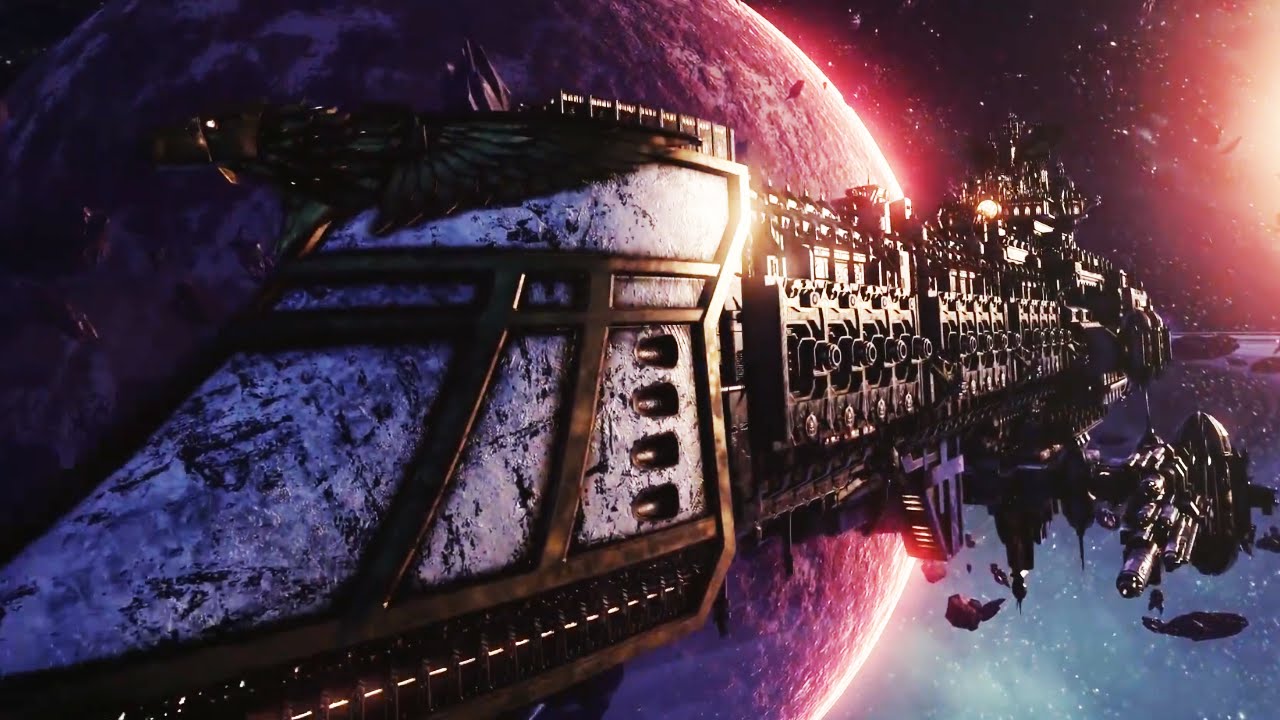
If there is one thing that stands out amongst the vast field of fleets, it’s the explosions that ripple through the hulls of both friend and foe. Set against gorgeous backdrops of asteroid fields, planets and suns, the world of “Battlefleet Gothic: Armada” is a beautiful and violent one. Beautifully violent. As mentioned previously, the model designs go above and beyond what perhaps even die hard hobbyist envisaged as they moved miniatures and threw dice across tables enacting these very same conflicts. Each ship has been crafted to suit the faction and although they come with their own unique designs, each faction maintains a coherent appearance throughout the game. And it really makes destroying the beautifully-rendered enemy fleet so much more satisfying. The projectiles launched from ships explode against enemies in flashes of color, lances of silver and white searing through ships and cannon fire burning through space on its course to the enemy.
The ships themselves are not the only spectacle on display - although seeing a critically-damaged ship detonate the first time and become engulfed in a fireball as wreckage scatters through space is a sight to behold in and of itself. The game is vibrant, the backdrops to battles are alive with colors and stellar bodies. The overall effect it delivers is a battlefield filled with intense action and one that at times, can be visually overwhelming when multiple ships are involved in a close quarter’s battle.
And I don't mean that in a bad way.
Gameplay
The impressive visuals cannot hide the fact that the title finds itself somewhere between engrossing RTS and micromanagement test. The cumbersome, city-sized ships are presented as lumbering monstrosities of technology that slowly cruise through space on their way to conflict with only occasional bursts of speed. Even the sleek and speedy Eldar are presented with slow craft with the exception that their bursts of speed are more frequent than the other factions. Ships do, however, have a maneuver gauge that depletes as you carry out more drastic turns, such as 180s, or twisting suddenly to bring your broadsides to bare or to move out of the way of a salvo of torpedoes.
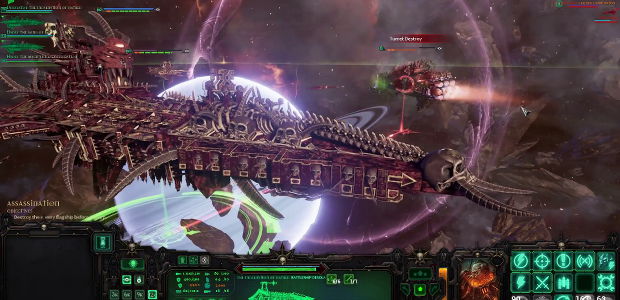
Combat itself is controlled from each ship, their abilities and skills activated while interacting with its interface. The ships can be ordered to carry out some basic orders themselves, setting their combat range and whether they confront enemies with broadsides or their prow weapons. In practice, this has its limited uses, as the AI reacts on it's own to combat situations - such as losing your starboard weapons, which the AI responds by having it turn the ship to use the port guns. However, the AI never really react like a player. The battles can be fierce, they can be violent and the explosions spectacular but at times it feels like you're waiting for cool downs to complete as ships circle one another and you end up just cycling between different ships and abilities, checking how long before the next one becomes available. If you focus too much attention on a single confrontation within the battle you could easily lose a ship due to the AI carrying out an engagement that was not in its favor. Granted, without your direction, your ships will only ever engage enemies that come close, the AI will not actively seek out enemies.
While the larger ship battles (up to 10 ships) are epic, the smaller engagements are the most enjoyable. Being able to manage smaller fleets and strategically working toward the best tactical advantage is very rewarding. When the fleet size is increased it’s very easy to miss an important moment in a battle, losing key ships or other advantages.
Should your ships find themselves isolated, under fire or badly damaged there is the potential that the captain of the ship may choose to abandon the fight and immediately fleeing the battlefield. However, with only a measure of joy ,you can choose to carry out the execution of the cowardly captain, halting their attempts to flee but sacrificing any levels and skills the captain has gained to this point.
Summary
“Battlefleet Gothic: Armada” is a mixed bag of both success and potential. It is a faithful recreation of the 40k universe and is a much darker, a more Gothic experience (if you excuse the pun), than we have previously been given in the "Dawn of War" titles. The game has a fun, if difficult to master combat system and benefits from an impressive array of visuals which showcase the sheer destructive abilities that these ships have. The campaign throws players into a detailed and engrossing war for control of the sector and rewards ambitious and clever commanders. The battles themselves can swing between short confrontations that may only last a few minutes to overwhelming conflicts which feel almost impossible and take a long time to complete. "Battlefleet Gothic; Armada" does a lot of things right, though there are certainly areas which can be improved upon. This title, much like "Mordheim," caters to a particular niche area and although it has the potential to draw in a wider audience will most likely find itself a favorite amongst people that are already fans of the 40k universe.
Pros
- Impressive Graphics
- Engaging Campaign
- Explosive Combat
Cons
- Lack of 3D enviroment
- Combat system difficult to understand at times.
- Multiplayer System needs improvement.
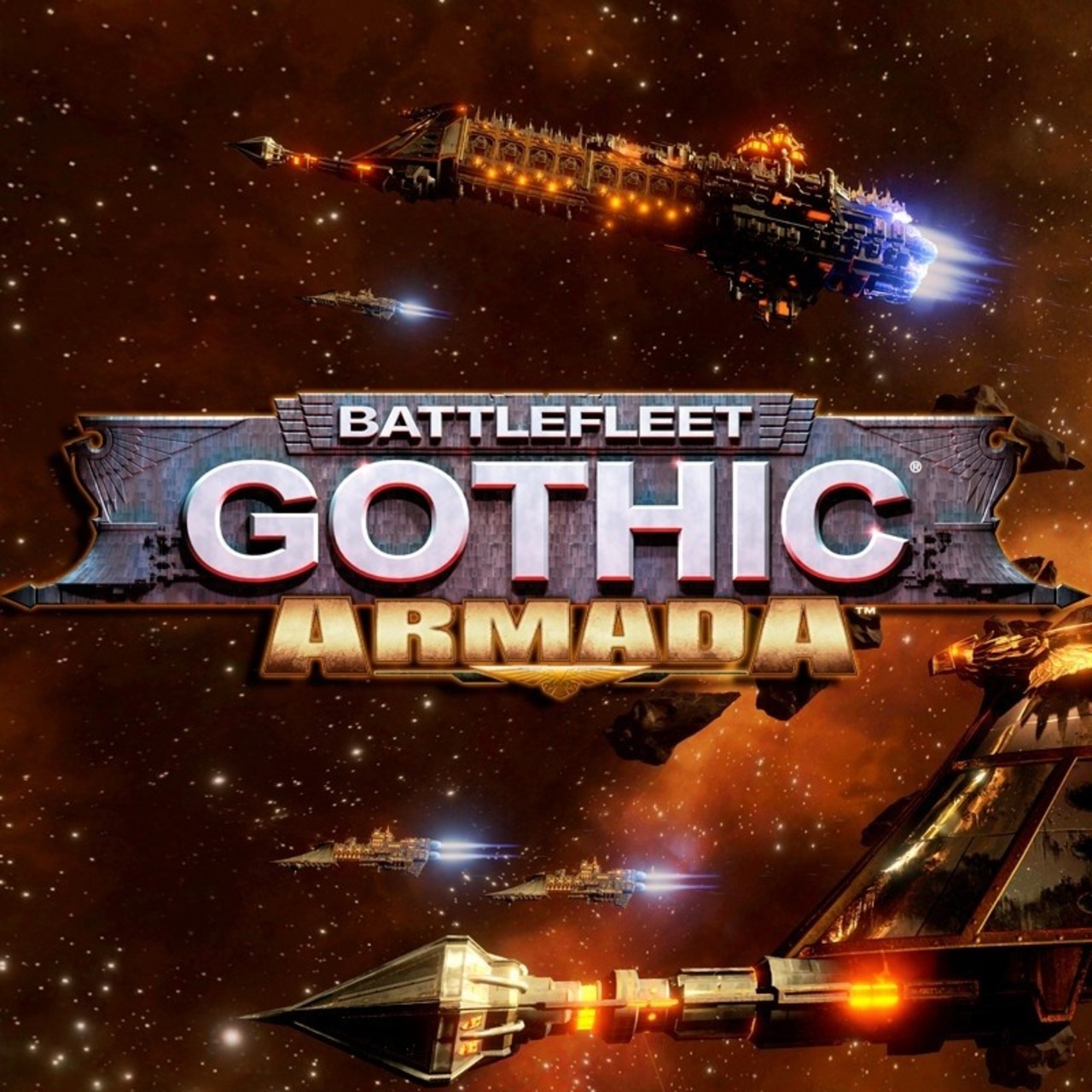
Battlefleet Gothic: Armada 8 / 10 Read our Review »
Release: 4/20/2016 [NA]
Publisher: Focus Home Interactive
Platforms: PC
Genres: Real-Time Strategy
Purchase: Amazon